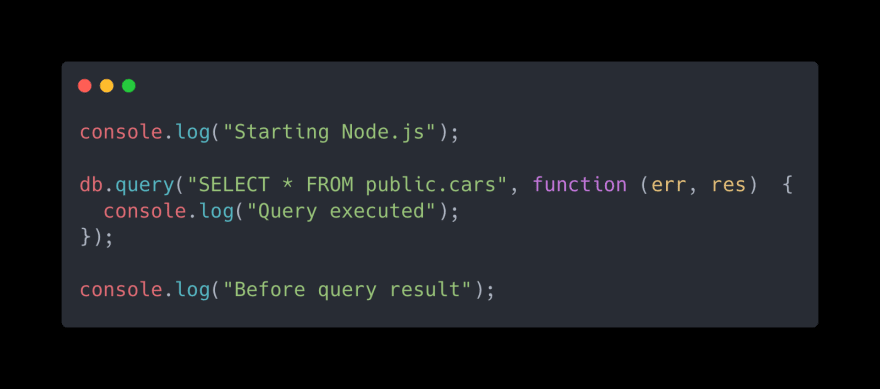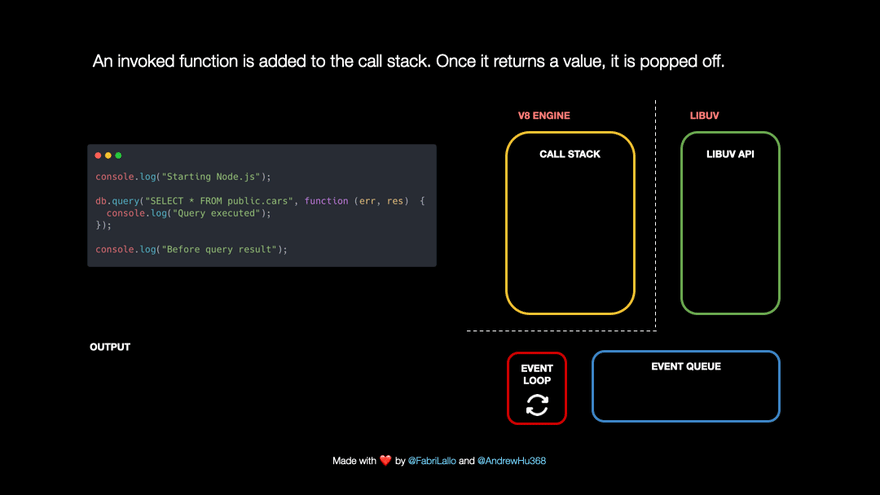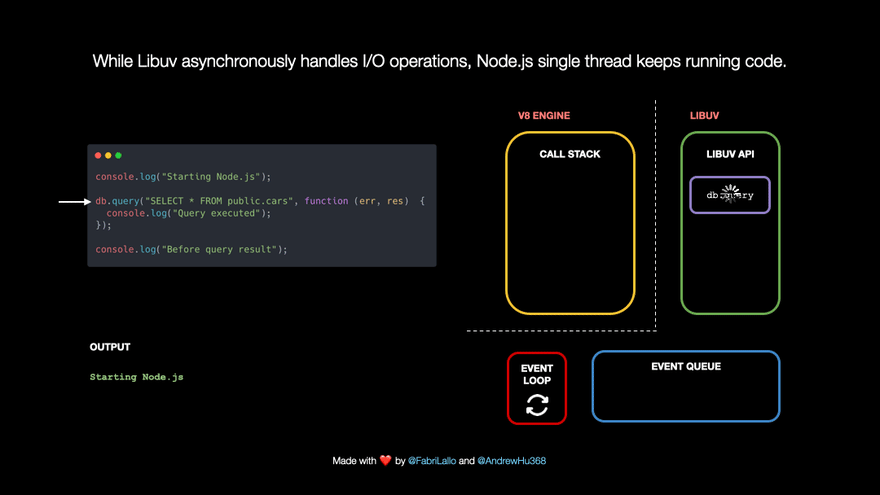We have all heard about JavaScript and Node.js being single-threaded, but what does it mean in practical terms?
It means that JavaScript can do one thing at a time. For example, we cannot simultaneously multiply and sum numbers. We usually do operations in sequence. We add and then multiply or vice versa. Modern computers are fast, and the result of two or more consecutive tasks seems to be computed simultaneously, but there are exceptions.
We all have tried to scrape data from that slow website or waited more than thirty seconds before getting the result of a database query. Do we want to block our single thread from executing more tasks because of a slow database query? Luckily, Node.js doesn’t stop from running other operations because of Libuv, a C++ library responsible for the event loop and asynchronously handling tasks such as network requests, DNS resolution, file system operations, data encryption, etc.
What happens under the hood when Node.js works on tasks such as database queries? We will explore it by following this piece of code step by step.
The V8 JavaScript engine manages a call stack, an essential piece that tracks which part of our program is running. Whenever we invoke a JavaScript function, it gets pushed to the call stack. Once the function reaches its end or a return statement, it is popped off the stack.
In our example, the line of code console.log('Starting Node.js') is added to the call stack and prints Starting Node.js to the console. By doing so, it reaches the end of the log function and is removed from the call stack.
The following line of code is a database query. These tasks are immediately popped off because they may take a long time. They are passed to Libuv, which asynchronously handles them in the background. At the same time, Node.js can keep running other code without blocking its single thread.
In the future, Node.js will know what to do with the query because we have associated a callback function with instructions to handle the task result or error. In our case, it is a simple console.log, but it could be complex business logic or data processing in production applications.
While Libuv handles the query in the background, our JavaScript is not blocked and can continue with console.log(”Before query result”).
When the query is done, its callback is pushed to the I/O Event Queue to be run shortly*.* The event loop connects the queue with the call stack. It checks if the latter is empty and moves the first queue item for execution.
The code is available at https://github.com/fabrilallo/event-loop-1
Pop quiz on the event loop
Try to figure out what the following code prints on the console.
Conclusion
The event loop, the delegation, and the asynchronous processing mechanism are Node.js's secret ingredients to process thousands of connections, read/write gigantic files, handling timers while working on other parts of our code.
In the article, we saw the vital role of Libuv and its ability to handle numerous potentially long-running tasks. At the same time, we went through the event loop and its role as a bridge/connector between callbacks of asynchronous operations in the I/O event queue and the call stack. In the following articles, we will explore in greater detail how timers, I/O, promises, and ticks are handled by the different phases of the event loop.
If you liked the article, follow us on Twitter @fabriziolallo and @andrewhu368














Top comments (48)
For anyone interested, I gave a conference talk on this a couple months ago: https://www.youtube.com/watch?v=KKM_4-uQpow&ab_channel=UtahJS
It's "A Deep Dive into the Node.js Event Loop", complete with tons of code examples so you can see these concepts in action. Here's the GitHub repo as well: github.com/thawkin3/nodejs-event-l...
Woh Tyler, Your explanation about the topic is one of the best i ever heard, You helped me put together two important concepts that are the task queue and the phases, Thank you Tyler.
Thanks Bento! That's very kind of you.
Amazing Talk. Thank you Tyler.
Thanks Debajyoti! Glad you liked it.
How does nodejs know which task should be handled by libuv ?
Not an exhaustive list:
Redacted on 8/11/2023
It's not even close to how it actually works. There's no "event queue" (or in other words there are multiple and not exactly queues). "the event loop" has no relation to Node, it's libuv thing, the only relation is that
libuvwas extracted from early version of Node,process.nextTicknever reaches "the event loop" (the one in libuv), Node doesn't run anything in it's single thread while libuv is busy with the query. If it is a single query and there are not timers andsetImmediate-s then the whole thing will be blocked onepollin linux case waiting on that query to return. If there are timeouts then it'll poll thatepollwith timeout of0and move onto timeouts.Go to libuv, look at file operations API and compare it to Node's file operation API.
For demonstration purposes I wrote a very simple and primitive http server using raw
libuv- github.com/tnymlr/hello-libuv/blob...Node does very similar thing with the difference that it's running V8 in those handlers.
You JS code runs in libuv handlers with the exception of the entry file, the entry file runs before the event loop has even started.
Thank you for your valuable feedback. It is a simplified version of this complex mechanism and we couldn't capture all the details as you mentioned. Would you like to connect on Twitter to improve the animations?
Thanks sir.
hi the last image in this article is being broken, could you please fix it!
Does it mean that Promises, timeouts and intervals are handled differently under the hood in browser and nodejs?
Chrome uses
libeventfor the event loop, but promises, timeouts, and intervals are processed in the same order in the two environments.Some things are available in node but not in browser. Ex.setImmediate. This shows that there are differences (even though there are many similarities).
As you know a task can be either asynchronous (non blocking) or synchronous (blocking) so for any task of asynchronous type nodejs pushes it to be handled by libuv and continue executing other synchronous tasks.
Is it true? I hear in some where, asynchronous is talk to non-blocking operations and vice versa synchronous is blocking operations or I'm wrong.
Yes you are correct..updated the comment.
Does Node works like this:
I've learned how javascript works in background, with example of GEC (Global Execution Context),
Call stack is populated with GEC:
1) console.log("Starting Node js"),
2) db.query()...
3) console.log("Before query results")
Call stack is populated with GEC (this means we cannot handle async code) till we reached console.log("Before query results").
In this animation call stack is populated line by line, and it's empty after each line, for example if we have setTimeout function with 0ms instead of query as 2nd line, even it's async operation it would execute first, before second console.log because call stack is empty after each line.
Great article, learned a few things 👍✨💯
Helpful and interesting to read! Thanks!
Well done!
Very well explained, rich in details. Thanks @fabriziolallo and @andrewhu368
Thank you for explaining this, it helped me understand far more than other explanations in the past. Appreciate it.
Nice!
I have learned many things from this article. Thank you.
Thanks a bunch!!! 🫶🏻
Hey bro,
Loved the way you explained using GIFs.
Could you please share what tool you used to generate these GIFs?
Keynote on Mac
Thanks Bro!
Great animation to explain the concept! Kudos 🎉🎉
Once db.query is sent to libuv how does it manage the connection to the database and does it use the 4 threads in the threadpool. If there are of slow I/O (http reqeuest to another service or db calls) how is that manged in libuv?
Every OS supports different types of async I/O (file, networking, etc..), and Libuv provides an abstraction layer over different I/O OS implementations.
So under the hood Libuv simply use the networking I/O implemented by the OS to connect to the database server. Threadpool is used for complex and high intensive CPU I/O types in order not to block the Event Loop. So, tasks like DNS lookup, crypto functions and others, are executed in the threadpool.
Thank you so much for the best article!
It really impressive, but I have a little confusion which I need to get it's clear picture!
Callstack is stack and we have queue , which data structure do WEB APIs use to keep track of asynchronous tasks?